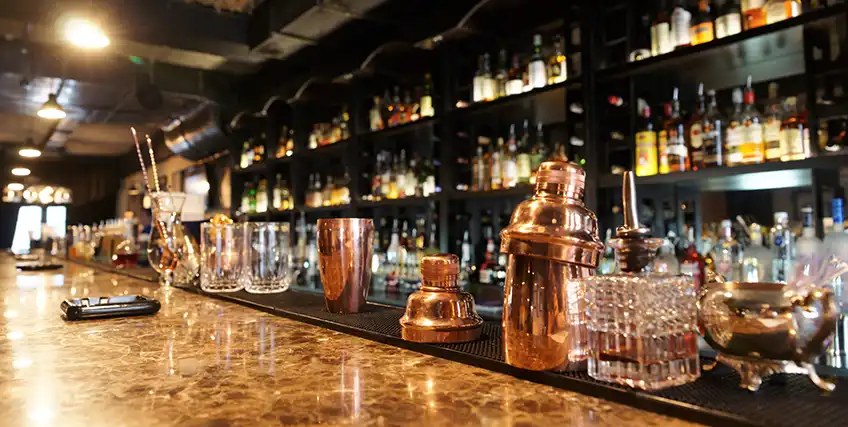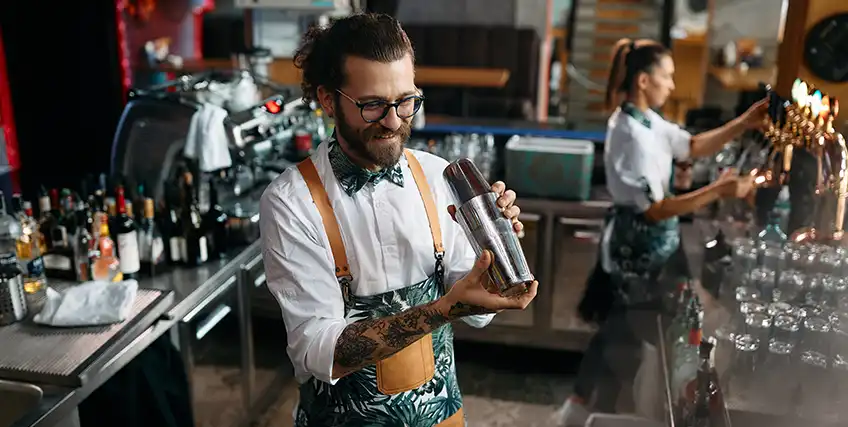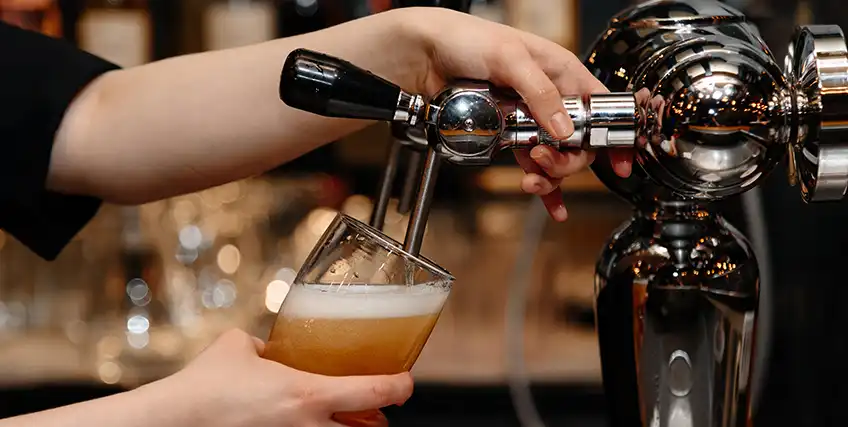Should You Lease or Buy Equipment for Your Bar? Loan Options Explained
April 01, 2025 | Last Updated on: April 02, 2025

Opening a bar is an exciting business venture for any outgoing entrepreneur but it's not a cheap one. Restaurant service Toast estimates it costs anywhere from $110,000 to $850,000 or more to open a bar. One of the most significant costs is bar equipment, and one of the biggest decisions you'll have to make is whether to buy or lease that equipment.
Small business loan financing offers solutions for aspiring bar owners, and bar business loans can help you cover the many costs of opening a bar, including buying bar equipment. However, there are also benefits to leasing equipment and using financing in other ways. Let's explore the benefits of buying vs. leasing.
- The types of bar equipment you'll need when starting a bar.
- Explore the benefits and drawbacks of leasing bar equipment.
- Explore the benefits and drawbacks of buying bar equipment.
Types of Bar Equipment That Can Be Financed
Like restaurant equipment, there's a wide range of bar equipment, and your needs will depend on your bar's specific operations and offerings. You'll need a host of small bar supplies like bar spoons, jiggers, pourers, muddlers, juicers, cocktail strainers, mixing glasses, and cocktail shakers as well as ingredients for cocktails like bitters, syrups, and garnishes, but you may not necessarily need financing to cover those. Basic bar and pub supplies can factor into your regular operating budget.
When financing a bar, you can leverage equipment loans or leasing for a range of larger bar equipment, including:
- Stoves
- Fryers
- Burners
- Oven
- Dishwashers
- Freezers
- Ice machines
- Refrigeration
- Blenders
- Mixers
- Food service trays
- Insulated food carriers
- Bar mats
- Outdoor coolers
- Cutting boards
- Rolling carts
- Mobile bar
- Steamers
- Beverage dispensers
- Espresso machines
- Coffee makers
- Glass racks
- Caddies
- Storage containers and shelving
- Safety equipment
- Sani-buckets
- Sinks
- Restaurant point of sale system
- Kitchen Display System (KDS)
This is just scratching the surface of the equipment. you'll need. From bar tools to glassware, napkins, and more, there are countless supplies necessary to run a restaurant.
Equipment Loans vs. Equipment Leasing
There are benefits to both loans and leases, regardless of industry. Let's take a closer look at each equipment financing option.
Benefits of Leasing Equipment
When you're just starting out, you may not have a lot of working capital or cash flow to work with. You also may not have any business credit to support a loan application.
Some of the key benefits of leasing over getting a loan include:
- Lower upfront cost: Rather than pay full price or drop a major down payment for a loan, leasing allows you to effectively rent high-quality equipment at a lower monthly price. This can free up capital for other parts of your business.
- Maintenance included: Usually, an equipment leasing contract includes maintenance, reducing your out-of-pocket costs to repair or replace equipment.
- Upgrade flexibility: As technology improves and better equipment becomes available, leasing gives you the flexibility to upgrade to new equipment after a lease term without staying on the hook for an equipment loan or having to sell a purchased piece of equipment.
- Fixed monthly payments: Every month, you’ll make the same payment, which makes it easier to manage your budget and cash flow.
- Tax benefits: Lease payments are usually tax-deductible as a business expense, reducing your end-of-year tax liability.
- Option to purchase: At the end of a lease, you usually have the option to either buy the equipment or return it and get something new. That gives you the flexibility to upgrade as your budget increases or purchase the equipment outright if it becomes essential to your operation.
Drawbacks of Leasing Equipment
While leasing is often the better option for new business owners who need a lot of bar equipment, it’s not without drawbacks:
- Higher overall costs: When you factor in the interest of a lease, you'll usually pay more long-term for a piece of equipment than you would with a loan.
- No ownership: Some small business owners would prefer to build equity in their equipment and eventually own it outright. When you lease, you don't own and can't use it as collateral for future loans or resell it.
- Longer repayment terms: Leases usually have longer repayment terms than loans, keeping equipment that may become obsolete on your books.
- Potential restrictions: With a lease, you're bound by the terms and conditions of the lease agreement, which may restrict your ability to modify or upgrade equipment.
- Inflexibility and inconvenience: Lease agreements are usually attached to single pieces of equipment. When you have a huge array of bar equipment needs, from drinkware and corkscrews to obscure barware like scoops, rimmers, presenters, and speed rails, you can't expect to lease every piece of equipment. Leases may only cover a few major items, leaving you to buy other bar and pub supplies with your own money.
Benefits of Equipment Loans
Although they may be challenging to get for new business owners or ones with bad credit, loans have several benefits over leases:
- Long-term flexibility: Owning a dependable piece of equipment is a very satisfying thing. You won't have to replace it any time soon and can rely on it for a long time.
- Offers collateral: Many small business loans require collateral, but with equipment loans, the financed item itself serves as that collateral.
- Builds business credit: As you make payments on a loan, you'll build a business credit score that can help you qualify for future financing.
- Lower interest rates: Typically, loan interest rates are lower than lease interest rates, although that's not always the case.
- Additional flexibility: You don’t have to secure a loan with a piece of equipment. If you explore larger bar business loans, you can get lump sum cash to cover a wide range of costs, from hiring to more specific back bar and pub supplies like bottle openers, straws, condiments, and other essentials.
Drawbacks of Equipment Loans
Buying bar equipment with a loan offers greater flexibility for covering many expenses than leasing does, but it's not without drawbacks:
- Greater upfront costs: Although equipment loans don't always require a down payment, you'll likely have to make one if you’re exploring more extensive small business loan financing. For instance, if you're getting a loan for a nightclub to cover bar equipment, bartending tools, lighting, a sound system, and more, you may need a down payment to give the lender some security.
- Equipment could become outdated: Technology advances at a rapid rate today. If you buy top-of-the-line bar equipment today, there’s no guarantee it will remain cutting-edge for years to come. If it does, you'll still be on the hook for the loan while using outdated equipment.
How to Finance Bar Equipment
Regardless of whether you want to buy or lease equipment, you'll have financing options available from traditional lenders like banks and credit unions, online lenders, and equipment manufacturers. Lease agreements can often be made with an equipment dealer or directly with the manufacturer.
If you want to get financing for a bar business to cover bar equipment among other costs, consider the following options:
- Term loans: These conventional loans provide borrowers with a lump sum upfront in exchange for a monthly payment plus interest. With few restrictions on how you use the money, you could purchase major bar equipment like a mobile bar or glass washer, as well as smaller items like stirrers and wine glasses, or even liquor bottles for inventory.
- SBA loans: Loans backed by the United States Small Business Administration (SBA) offer competitive interest rates and loan terms. However, they usually have strict eligibility requirements than traditional lenders, and much stricter than online lenders. Nonetheless, the SBA 7(a) loan program is one of the most popular among small business owners for good reason.
- Business lines of credit: These flexible financing options offer borrowers a maximum available loan amount, but only charge interest on amounts that are withdrawn. With a revolving line of credit, you can repay what you withdraw to regain access to the full credit line again. This gives you flexible spending power for bar equipment as you need it.
- Equipment financing: If you have a very specific equipment need, you can purchase it with an equipment loan that uses the equipment itself as collateral to secure the loan. In some cases, you can also set up a lease-to-own agreement that gives you the option to buy equipment at the end of an initial lease period.
Final Thoughts
Financing a bar can be challenging, especially for new business owners. There are so many individual pieces of bar equipment you need, it may feel overwhelming when you're trying to check so many boxes. This is one key reason why a more flexible bar business loan may be a better option. Not only can you use the loan amount to buy major equipment, but you can also get necessary bartending tools, and cover additional costs like overhead, hiring, and marketing.
Regardless of whether you choose to lease or get a loan, you should always have a strong business plan. This will not only guide your decision-making, but it's an invaluable asset to show to lenders, along with financial disclosures, tax returns, and other bank statements to support your loan application.
FAQs about Bar Equipment
How much does it cost to open a bar?
Restaurant service Toast estimates the cost of opening a bar to be between $110,000 and $850,000. One of the biggest expenses is bar equipment.
How much does bar equipment cost?
Equipment costs range considerably depending on the type of equipment you need, whether you’re buying or leasing, and current available interest rates.
Can I finance bar equipment if I have bad credit?
Usually, you will still be able to finance the equipment using the equipment itself as collateral to secure the loan. If you fail to make payments, the equipment will be repossessed. You may struggle to get approved for larger loans, however, and may have better luck with an online or alternative lender than with a bank.
Do I have to do a credit check to finance bar equipment?
Usually, yes. Whenever you apply for a loan or lease, you'll typically have to submit to a credit check which will inform you of your eligibility for financing and your interest rate.
Should I buy or lease bar equipment?
It depends on your preference. Buying usually carries the benefits of lower interest rates and can help you build business credit if you're using a loan. Leasing will cost less upfront and allow you to keep updating equipment every few years.




